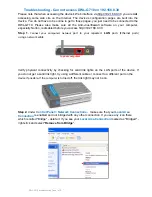
Introduction to OSPF Configuration Tasks
307
■
AS-external-LSA: Type-5 LSA, also called ASE LSA, generated by ASBRs to
describe the routes to other ASs and advertised to the whole AS (excluding
stub areas). The default AS route can also be described by AS-external-LSAs.
Type-7 LSAs
In RFC 1587 (OSPF NSSA Option), Type-7 LSA, a new LSA type, is added.
As described in RFC 1587, Type-7 LSAs and Type-5 LSAs mainly differ in the
following two ways:
■
Type-7 LSAs are generated and advertised in an NSSA, where Type-5 LSAs will
not be generated or advertised.
■
Type-7 LSAs can only be advertised in an NSSA area. When Type-7 LSAs reach
an ABR, the ABR can convert part of the routing information carried in the
Type-7 LSAs into Type-5 LSAs and advertise the Type-5 LSAs. Type-7 LSAs are
not directly advertised to other areas (including the backbone area).
OSPF Features
Switch 7750 support the following OSPF features:
■
Stub area: Stub area is defined to reduce the cost for the routers in the area to
receive ASE routes.
■
NSSA area: NSSA area is defined to remove the limit on the topology in a stub
area.
■
OSPF multi-process: Multiple OSPF processes can be run on a router.
■
Sharing discovered routing information with other dynamic routing protocols:
At present, OSPF supports importing the routes of other dynamic routing
protocols (such as RIP), and static routes as OSPF external routes into the AS to
which the router belongs. In addition, OSPF supports advertising the routing
information it discovered to other routing protocols.
■
Authentication key: OSPF supports the authentication of the packets between
neighboring routers in the same area by using one of the two methods: plain
text authentication key and MD5 authentication key.
■
Flexible configuration of router interface parameters: For a router interface, you
can configure the following OSPF parameters: output cost, Hello interval,
interface transmission delay, route priority, dead time for a neighboring router,
and packet authentication mode and authentication key.
■
Virtual link: Virtual links can be configured.
Introduction to OSPF
Configuration Tasks
Table 230
OSPF configuration tasks
Configuration Task
Description
Related
section
Basic OSPF Configuration
Required
“Basic OSPF
Configuration”
on page 309
OSPF Area Attribute Configuration
Optional
“OSPF Area
Attribute
Configuration”
on page 311
Summary of Contents for Switch 7754
Page 32: ...32 CHAPTER 1 CLI OVERVIEW ...
Page 70: ...70 CHAPTER 5 LOGGING IN USING MODEM ...
Page 76: ...76 CHAPTER 7 LOGGING IN THROUGH NMS ...
Page 86: ...86 CHAPTER 9 CONFIGURATION FILE MANAGEMENT ...
Page 120: ...120 CHAPTER 13 ISOLATE USER VLAN CONFIGURATION ...
Page 126: ...126 CHAPTER 14 SUPER VLAN ...
Page 136: ...136 CHAPTER 16 IP PERFORMANCE CONFIGURATION ...
Page 152: ...152 CHAPTER 17 IPX CONFIGURATION ...
Page 164: ...164 CHAPTER 19 QINQ CONFIGURATION ...
Page 172: ...172 CHAPTER 21 SHARED VLAN CONFIGURATION ...
Page 182: ...182 CHAPTER 22 PORT BASIC CONFIGURATION ...
Page 198: ...198 CHAPTER 24 PORT ISOLATION CONFIGURATION ...
Page 208: ...208 CHAPTER 25 PORT SECURITY CONFIGURATION ...
Page 224: ...224 CHAPTER 27 DLDP CONFIGURATION ...
Page 232: ...232 CHAPTER 28 MAC ADDRESS TABLE MANAGEMENT ...
Page 240: ...240 CHAPTER 29 CENTRALIZED MAC ADDRESS AUTHENTICATION CONFIGURATION ...
Page 280: ...280 CHAPTER 30 MSTP CONFIGURATION ...
Page 348: ...348 CHAPTER 35 IS IS CONFIGURATION ...
Page 408: ...408 CHAPTER 39 802 1X CONFIGURATION ...
Page 412: ...412 CHAPTER 40 HABP CONFIGURATION ...
Page 422: ...422 CHAPTER 41 MULTICAST OVERVIEW ...
Page 426: ...426 CHAPTER 42 GMRP CONFIGURATION ...
Page 480: ...480 CHAPTER 47 PIM CONFIGURATION ...
Page 506: ...506 CHAPTER 48 MSDP CONFIGURATION ...
Page 552: ...552 CHAPTER 51 TRAFFIC ACCOUNTING CONFIGURATION ...
Page 570: ...570 CHAPTER 53 HA CONFIGURATION ...
Page 582: ...582 CHAPTER 54 ARP CONFIGURATION SwitchA arp protective down recover interval 200 ...
Page 622: ...622 CHAPTER 58 DHCP RELAY AGENT CONFIGURATION ...
Page 684: ...684 CHAPTER 61 QOS CONFIGURATION ...
Page 718: ...718 CHAPTER 63 CLUSTER ...
Page 738: ...738 CHAPTER 67 UDP HELPER CONFIGURATION ...
Page 752: ...752 CHAPTER 69 RMON CONFIGURATION ...
Page 772: ...772 CHAPTER 70 NTP CONFIGURATION ...
Page 796: ...796 CHAPTER 72 FILE SYSTEM MANAGEMENT ...
Page 802: ...802 CHAPTER 73 BIMS CONFIGURATION ...
Page 814: ...814 CHAPTER 74 FTP AND TFTP CONFIGURATION ...
Page 830: ...830 CHAPTER 75 INFORMATION CENTER ...
Page 836: ...836 CHAPTER 76 DNS CONFIGURATION ...
Page 852: ...852 CHAPTER 77 BOOTROM AND HOST SOFTWARE LOADING ...
Page 858: ...858 CHAPTER 78 BASIC SYSTEM CONFIGURATION DEBUGGING ...
















































